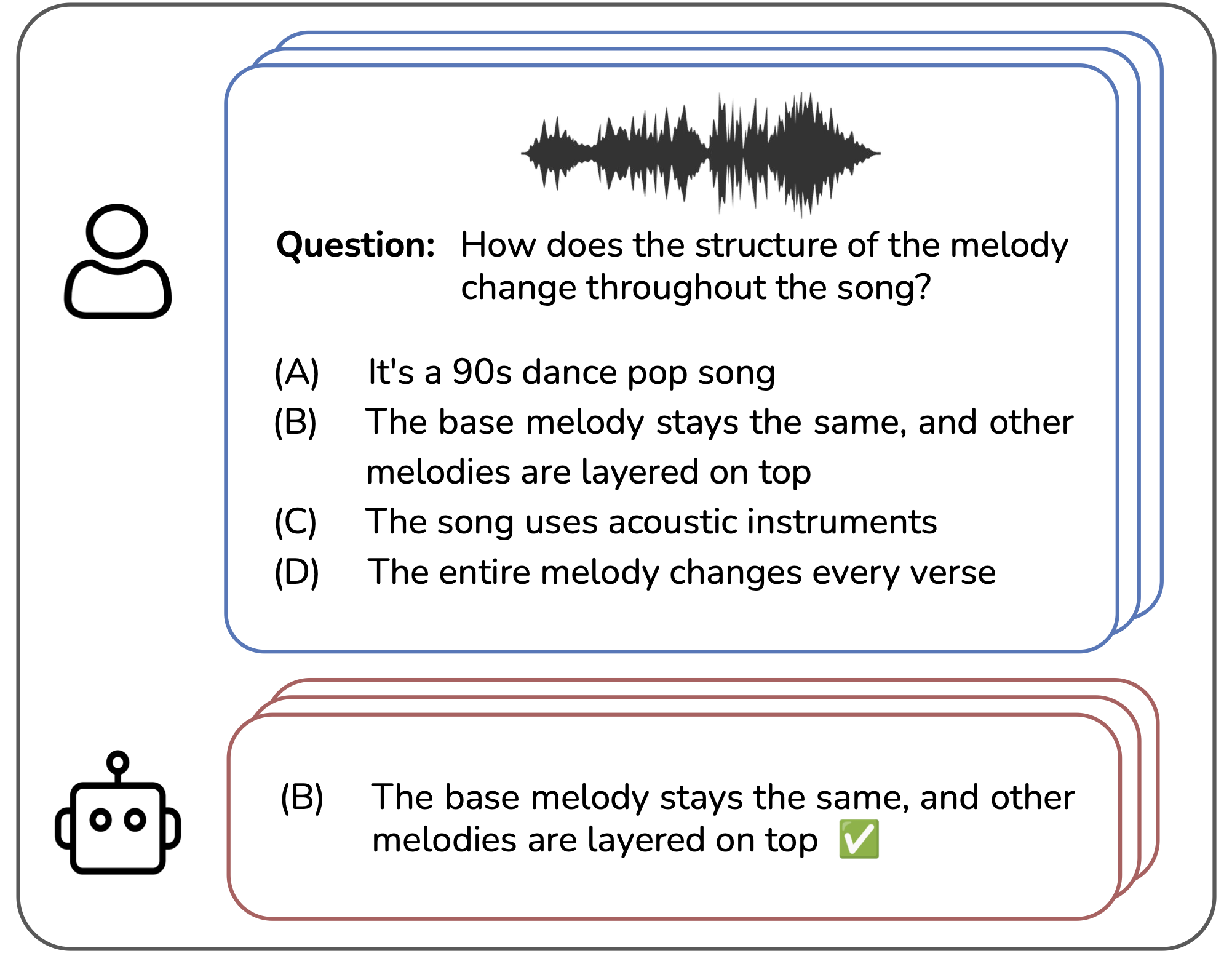Evaluation#
Reliably evaluating music description systems is a challenging endeavour. Even when we have “grounth-truth” captions, it is not always clear how to score generated text, as music description is open-ended, and at least partially subjective. The quality of a description is also strongly dependent on the context in which it is used. This issue gets even more pronounced with more dialogue-based tasks like MQA or other forms of instruction-based description. Comparing outputs to gold standard from static datasets can help, but it’s only the first step.
Overall, current strategies are usually a mix of automatic evaluation via reference-based metrics and human evaluation, alongside newer protocols designed to assess language generation. Let’s review automatic evaluation in more detail below.
Match-based metrics#
A common approach for automatic evaluation of captioning systems relies on metrics that score the syntactic or semantic similarity between the generated caption and a set of reference captions. Borrowed from the computer vision and NLP literature, these metrics were originally created to evaluate text output in machine translation (BLEU, METEOR, ROUGE), image captioning (CIDEr, SPICE, SPIDEr) or other text generation tasks (BERT-Score). As we will see, their use in evaluating music captioning isn’t without issues, but they continue to be used in objective evaluation as they provide a convenient way to compare generated text to reference captions.
We briefly review each of these metrics below:
BLEU measures the similarity between candidate and ground-truth captions by taking the geometric mean of the \(n\)-gram-based precision \(P_n\), using either only unigrams (BLEU_1), or combinations of n-grams up to 4 (BLEU\textsubscript{4}). The final computation of the score also includes a brevity penalty term to discount, at an aggregate level, candidate text that does not match the reference text in length.
METEOR also measures the similarity between generated and reference captions, but does so by combining an \(F\)-score – the harmonic mean of unigram precision \(P_1\) and recall \(R_1\) – with a penalty term which reduces the score based on the number of longer \(n\)-grams matched between candidate and reference text.
ROUGE, commonly used in text summarisation, is similarly based on an F-score computed from matches of overlapping units between generated and ground-truth text. Depending on the length of the units considered, this metric comes in different variants. Among them, we adopt ROUGE\textsubscript{L}, which considers matching between the longest common subsequence instead of using predefined \(n\)-grams lengths.
CIDEr is instead designed to capture human consensus by measuring how well a candidate caption matches the majority of reference captions. This is done by adding the average cosine similarity between tf-idf weighted \(n\)-grams of candidate and reference text for different values of \(n\) (typically \(n=\{1, 2, 3, 4\}\)), leading to better correlation with human judgement in image captioning, compared to match-based metrics.
SPICE is based on a comparison of semantic similarity of scene graphs, representations of objects and their relationship parsed from the candidate and reference caption. These abstract away much of the lexical and syntactic characteristics of the captions, focusing instead on semantically meaningful components of the text.
SPIDEr is a linear combination of SPICE and CIDEr.
BERT-Score also computes the similarity between tokens in a generated sentence and tokens in the ground-truth text, but does so using contextual embeddings obtained from a pre-trained BERT model instead of exact matches, resulting in a higher correlation with human judgements.
Limitations#
While a useful starting point in evaluating model outputs on more closed-ended tasks, these metrics are unable to capture all admissable variations in music description. For example, given a music track, there may be several possible captions that are equally valid but share very little in terms of syntactic or semantic similarity. Both in the music domain and in others such as general audio description, many studies have highlighted important limitations of these metrics, for example showing they fail to account for valid variations in captions and to align with human judgement [LL24]. For this reason, including human evaluation and task-specific benchmarks is necessary for a more well-rounded evaluation.
Benchmarks#
To overcome some of the shortcomings of match-based metrics, a few benchmarks have recently emerged with the goal of assessing music understanding or description via multiple-choice question-answering. These also better suit the conversational format of more recent music description systems, as they focus on assessing responses to specific user prompts (questions). Some benchmarks of this kind are designed for general audio-language evaluation and include music as part of a wider range of domains. Among these are AudioBench [WZL+24] and AIR-Bench [YXL+24]. Others, including MuChoMusic [WMB+24] and OpenMU [ZZM+24], directly focus on music:

References#
Jinwoo Lee and Kyogu Lee. Do captioning metrics reflect music semantic alignment? In International Society for Music Information Retrieval (ISMIR) 2024, Late Breaking Demo (LBD). 2024. URL: https://arxiv.org/abs/2411.11692.
Bin Wang, Xunlong Zou, Geyu Lin, Shuo Sun, Zhuohan Liu, Wenyu Zhang, Zhengyuan Liu, AiTi Aw, and Nancy F Chen. Audiobench: a universal benchmark for audio large language models. arXiv preprint arXiv:2406.16020, 2024.
Benno Weck, Ilaria Manco, Emmanouil Benetos, Elio Quinton, George Fazekas, and Dmitry Bogdanov. MuChoMusic: Evaluating Music Understanding in Multimodal Audio-Language Models. In 25th International Society for Music Information Retrieval Conference. August 2024. arXiv:2408.01337 [cs, eess]. URL: http://arxiv.org/abs/2408.01337 (visited on 2024-08-21), doi:10.48550/arXiv.2408.01337.
Qian Yang, Jin Xu, Wenrui Liu, Yunfei Chu, Ziyue Jiang, Xiaohuan Zhou, Yichong Leng, Yuanjun Lv, Zhou Zhao, Chang Zhou, and Jingren Zhou. AIR-bench: benchmarking large audio-language models via generative comprehension. In Lun-Wei Ku, Andre Martins, and Vivek Srikumar, editors, Proceedings of the 62nd Annual Meeting of the Association for Computational Linguistics (Volume 1: Long Papers), 1979–1998. Bangkok, Thailand, August 2024. Association for Computational Linguistics. URL: https://aclanthology.org/2024.acl-long.109, doi:10.18653/v1/2024.acl-long.109.
Mengjie Zhao, Zhi Zhong, Zhuoyuan Mao, Shiqi Yang, Wei-Hsiang Liao, Shusuke Takahashi, Hiromi Wakaki, and Yuki Mitsufuji. OpenMU: Your Swiss Army Knife for Music Understanding. October 2024. arXiv:2410.15573. URL: http://arxiv.org/abs/2410.15573 (visited on 2024-11-09).
